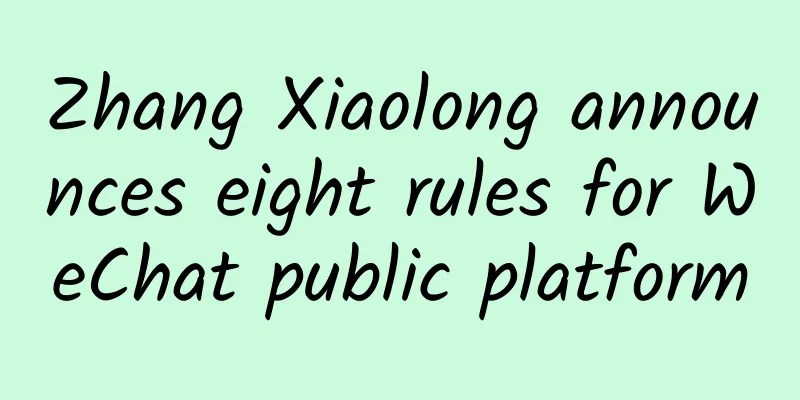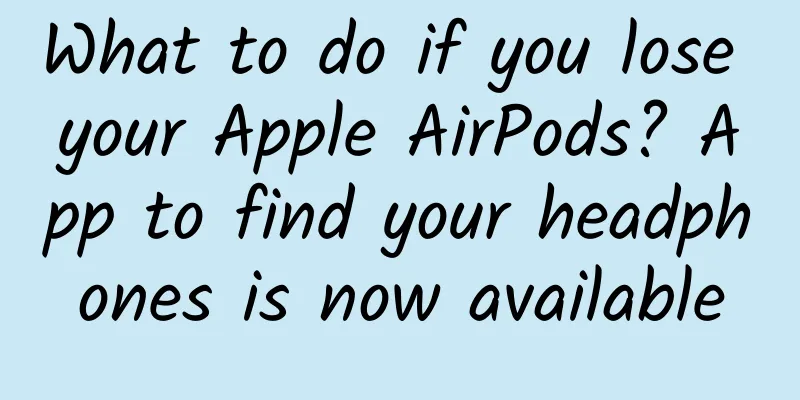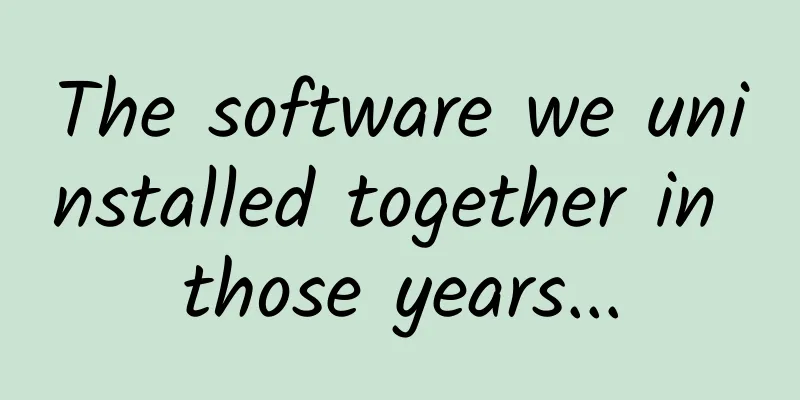Zhang Xiaolong announces eight rules for WeChat public platform

|
The "WeChat Open Class PRO Edition" was held in Beijing today. Zhang Xiaolong, senior executive vice president of Tencent and president of the WeChat business unit, publicly announced for the first time the eight rules of the WeChat public platform. These eight points are summarized as follows. 1) Encourage valuable services What is a valuable service? For example, a few years ago, during the blog era, blogs were very popular, but after a while, they gradually declined. After we created the public platform, we were very surprised to see that self-media and some former bloggers re-invested in it, and more and more good original articles appeared in the public platform. As a platform, we are very happy to see such investment. From this perspective, we are very encouraging that excellent articles can appear in the public platform. We believe that this is a very valuable service for users, so we also involve a lot of other various contents. You will also find that our platform will take some strict measures to control a lot of content. For example, we will impose some restrictions on various content that induces users to share on WeChat Moments, or on copyright issues or H5 games. We will always keep in mind which content is valuable to users and which is not. This is the first point. We encourage truly valuable services to appear on WeChat’s public platform. 2) Eliminate geographic restrictions So what are geographical restrictions? When we were thinking about the WeChat public platform, we were thinking about what kind of business we wanted to promote. We know that the Internet actually drives people's communication beyond geographical limitations, especially with the mobile Internet, everyone can be involved in a kind of communication that transcends time and space. Geography used to be an important factor in business in the past. For example, a shop may need to find a very good location to be valuable, but the flow of people on the mobile Internet is actually not very dependent on some geographical restrictions. At that time, we imagined a scenario, and we will use this as an example. For example, a blind masseur may not need to rent a store. As long as his skills are good enough, he can provide his massage services in a not very good store. We hope to bring a very good customer traffic to those businesses that do not have geographical advantages. We think this is very possible in the era of mobile Internet. 3) Eliminate intermediaries Eliminating intermediaries may be a very ambitious goal. Because all businesses may rely on a lot of intermediate links, but since we have established the public platform, we hope that merchants can directly provide a service through the public platform. The reason why this service is possible is that if merchants are also involved in the public platform, and consumers are also involved in the public platform, then they can be connected to each other. This model may have been unimaginable in the past, because it was difficult for merchants to communicate directly with consumers. The public platform provides such a possibility. We strongly encourage merchants and consumers to communicate directly in the public platform, which is why it seems that everyone can have a direct conversation with merchants in a conversation window in the public platform. 4) Decentralization There may be many different understandings of decentralization. Our understanding is that WeChat will not provide a centralized traffic entrance for all public platforms and third parties. On the contrary, we encourage third parties to organize their own customers in a decentralized manner. For example, we proposed a long time ago that in the PC Internet era, the entrance to traffic may be in the search box, but in the mobile Internet era, we think that the entrance to traffic may be in the QR code. So WeChat has been vigorously promoting the popularization of QR codes in China for a long time. Because in terms of offline traffic, people need a medium that can connect their mobile phones to a certain service. From an offline perspective, we think QR codes are a good way. So far, it is difficult to see a centralized form of public account in WeChat. We are also very proud of this, because after a new user installs WeChat, he really can't find an entrance called public account or public platform in WeChat. If he doesn't follow any public account, he may not see the existence of any public account or public platform. However, there are nearly 10 million public accounts that are very active in WeChat every day. Their activity is brought about by their own efforts. WeChat does not provide them with a central entrance. This is a manifestation of our decentralization in WeChat. At the same time, we also encourage all merchants or third-party service providers to organize various resources through the public platform. This is why we have always taken a more cautious approach to public account subscriptions. 5) Building an ecosystem Many people ask us: WeChat can do everything. They also worry about what will happen if WeChat does what they do. But WeChat will not do everything. One of the reasons is that we hope to build an ecosystem based on WeChat, rather than building every part of the ecosystem ourselves. Simply put, we want to build a forest, not build our own palace. We hope that the entire forest can be used to cultivate an environment where all organisms, plants and animals can grow freely in the forest, rather than building it ourselves. 6) The public platform is a dynamic system Many friends would say that the WeChat platform rules do not seem clear enough, or that our rules are not clear enough. So much so that I feel there is some confusion here, but what I want to tell you is that we do not think that a system with 100% certain rules is a good system. On the contrary, we believe that a dynamic system is a system that is more capable of achieving dynamic stability. Therefore, we believe that third parties should work with us to build a system, rather than us building a complete system. Since we are doing this together, we believe that this system should be a dynamic, self-improving system rather than a rigid system. Even the entire system was defined by us and a third party. Therefore, you will see that WeChat and the public platform will continue to change. Our changes are to enable our system to achieve dynamic stability. 7) Social traffic You will find that WeChat rarely provides a neutral traffic entrance, but it does not prevent many scenarios that require traffic from being activated. For example, WeChat red envelopes, WeChat games, and even some hardware-related such as sports bracelets. Bracelets are also a good example. We will standardize the step data of bracelets so that a bracelet user can compete with other bracelet users. This is a typical social traffic scenario. We will continue to explore this type of traffic scenario in the future and provide it to the users of the platform. 8) All considerations are based on one premise: user value first We have just talked about so many concepts of WeChat, but in the end, we must put user value first, otherwise it may damage the health of the entire platform. So you will see, for example, the management of Moments. Users need to see a variety of content in Moments, but we will manage it and clear out some content that harasses users or that users don’t want to see. For public platforms, just like subscription accounts, a lot of readings come from Moments, which conforms to the 2/8 principle: 20% of users go to subscription accounts to select content, and then 80% of users read the content in Moments. We are happy that this traffic can work, but everything happens with user approval. The above eight points are some of our thoughts on the direction and concept of the public platform. We share them here and hope that third-party developers can have more understanding and support for our platform. |
<<: Three major features of Objective-C: encapsulation, inheritance, and polymorphism
>>: Qualcomm announces $40 million strategic investment in touch technology
Recommend
Cook said at the hearing that all developers are treated equally, but the evidence shows otherwise
Apple CEO Tim Cook testified before the U.S. Cong...
What to do if your immunity is low? How to improve your immunity? Learn more in one article
It is said that only idiots catch colds in summer...
When technology meets archaeology: "Identifying bones and tracing traces" makes cultural relics "speak"
Produced by: Science Popularization China Author:...
The May Day brand traffic grab
As the May Day holiday approaches, various indust...
Chen Chao: 60 Inventions That Influenced the World
Chen Chao · "60 Great Inventions That Influe...
When a person is crying, he starts to "twitch", not because of fear but because of "poisoning"
When we were young, we might be beaten by our par...
How to explore user needs? Follow these 5 steps!
We are always asked to explore user needs. How do...
Is information flow too expensive? Tell you how to create the effect of 5 million with 500,000!
With the expansion of social networks , the incre...
How to create a new Douyin account? Tik Tok live broadcast review!
Recently, there are still many businesses that ar...
Super useful information! Check out which websites the operations experts usually visit and save them quickly!
For those who work in operations , who doesn’t ha...
After analyzing more than 500 e-commerce applets, I discovered three major rules for becoming popular
This article first analyzes the reasons for the r...
New way to play group lottery activities!
Group buying is regarded as a social method under...
It doesn't matter if the brand is small, Lantu Zhiyin focuses on all-round leapfrogging, with 800V and intelligent driving as standard for 200,000 yuan
People often say that China's new energy vehi...
TikTok advertising, TikTok advertising display format
TikTok advertising relies on big data recommendat...
"91 Ten Articles" - A daily must-read briefing for the new energy vehicle industry (210127)
1. Zhuhai State-owned Assets Supervision and Admi...









